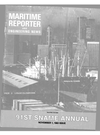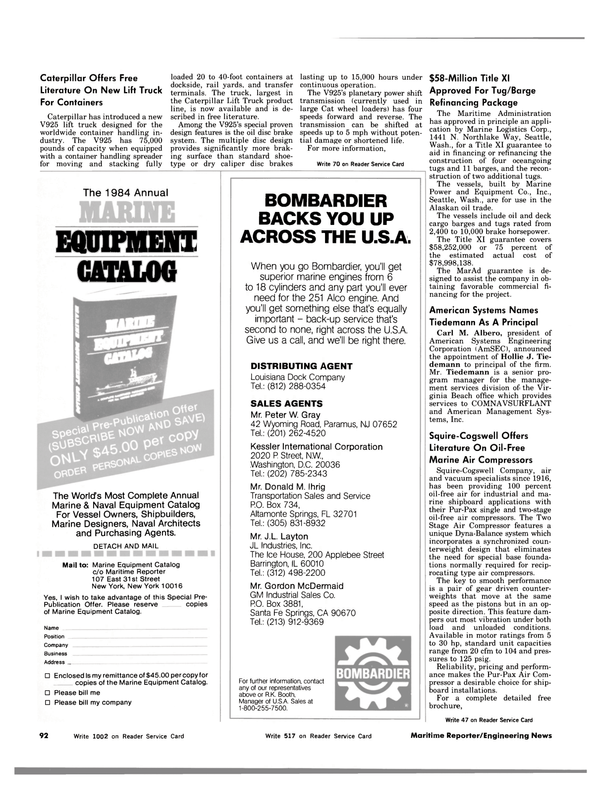
Innovative "Flexor" Barge Connector Allows Blue Water Barge Trains
"Trains" of freight barges crisscrossing the world's oceans, lakes and rivers, is the goal set by the Barge Train Division of American Metal Bearing, Inc., which has announced the introduction to the commercial market of its "Flexor," a flexible steel and synthetic rubber barge connector that makes barge trains possible and opens a new area of additional revenue opportunities for barge operators worldwide.
Free literature is available describing the entire concept in detail.
Making the announcement, Alan Ducommun, president of the Garden Grove, Calif., firm, stated that the introduction of the Flexor and the Barge Train concept to commercial shipping will, for the first time, bring the cost and convenience advantages of barging to blue-water transportation around the world.
Mr. Ducommun stated there are three basic types of barge linkages: single hinge, multiple articulated connectors, and flexible couplings. Single hinges have limited ability to absorb the ocean forces. Articulated couplings are a big improvement, but may not absorb enough force. Flexible couplings theoretically could absorb these forces, but no one had been able to perfect them until John Marriner did it in the 1970s.
American Metal Bearing purchased Mr. Marriner's firm, Barge Train, Inc., and its Flexor patents, earlier this year. It also retained Mr. Marriner to help launch the product commercially.
Flexor allows relative motion between coupled barges substantially reducing the forces between them. An additional feature is that the Flexor can be coupled and uncoupled very quickly.
Mr. Ducommun noted that the Flexor has been extensively proven in the United States Navy, which has more than 200 in use and 140 more on order.
Mr. Ducommun said that the commercial version of the Flexor will enable four to six 150- to 200- foot-long barges to be connected and either pulled or pushed by a tug. Compared to the Navy's Flexor, the commercial version will be approximately twice as long and eight times as heavy.
Important advantages offered to commercial barge owners by the Flexor and the Barge Train concept include: (1) Additional revenue opportunities from expanded areas of operation; (2) Additional revenue from more efficient operation; (3) Relatively low initial cost; (4) Simple and inexpensive installation; (5) Quick and easy coupling even in open water; (6) Enables barge sections to ride waves while absorbing the sea forces; (7) Enough rigidity to enable pushing four to six barges by tug—pushing is more efficient than pulling; (8) Almost continuous tug operation—picking up, moving, and dropping off barges—minimum time wasted, maximizing efficiency; (9) Flexibility—barges of 2,000 to 8,000-ton displacement can be used as temporary warehouses; (10) Fast uncoupling in emergencies; (11) Barge Trains move faster—close-coupling safely permits increased speeds; (12) Larger payloads and faster speeds reduce costs and increase profits.
The commercial Flexor is approximately 14 feet long, 30 inches in diameter and weighs 8,000 pounds. Each end consists of a hollow tapered steel casting with a circumferential groove that accepts a guillotine latch which falls into locked position when the Flexor assumes its position in a barge receptacle.
A thick steel cable, running through the center of the Flexor, is tightened so the unit is in compression.
The Flexor receptacle is a reinforced steel tube welded into position.
Both ends of a barge have two or four receptacles. Hand winches at the inboard ends of each receptacle pull hawsers attached to each end of the Flexor bringing the two vessels together and guiding the tapered tip of the Flexor into the receptacle.
The units also can be set up for remote uncoupling in emergencies.
When the barges are connected, they are approximately 30 inches apart. When disconnected, Flexor units retract and store in the receptacles.
Since 1970, American Metal Bearing has been a major supplier of bearings to the U.S. Navy and to more than a dozen shipbuilding firms.
For free literature containing full details on the Flexor and the Barge Train concept, W r i t e 2 0 on Reader Service Card
Read Innovative "Flexor" Barge Connector Allows Blue Water Barge Trains in Pdf, Flash or Html5 edition of November 1983 Maritime Reporter
Other stories from November 1983 issue
Content
- Indonesia Signs $150-Million Agreement For 4 Boeing Jetfoils page: 5
- Joint Venture Formed By Union Carbide And MTL page: 5
- Marine Consultants To Conduct Study For MarAd On Bulk Carriers page: 6
- Glomar Robert F. Bauer Christened At FELS page: 6
- Global Marine Introduces New Designs For New Generation Of Heavy Weather Jackups page: 6
- McDermott Pla ns Study Of Fixed Platforms For 1,600-Foot Water Depths page: 7
- M i t c h e l l M a r i n e Delivers Fourth Service Boat page: 7
- North Sea Maureen Field Commences Oil Production page: 8
- Swift Group Management Promotions Announced page: 8
- Bay Shipbuilding Building Coal Topping Off Barge page: 8
- Radm. Nunneley New President Of ASNE page: 9
- Ship Survivability Topic Of Symposium In Philadelphia December 7 page: 10
- Miniliner Newport Clipper Delivered By Jeffboat page: 10
- Marinette Marine Awarded $6-Million Navy Contract page: 11
- ASNE Call For Papers For '84 Naval Ship Symposium page: 11
- Third ARS Keel Laying At Peterson Builders page: 12
- Navy Awards Tracor $7.7-Million Contract page: 12
- Thomas Marine Offers 38' Aluminum Crewboat —Literature Available page: 12
- Free Mobil Literature Details New Diesel Oil For High Output Engines page: 13
- Nav-Com Names Franza Director Of Marketing page: 13
- Nichols To Build New Seattle Fireboat page: 14
- Offshore Drilling Rig Sedco 602 Delivered By Promet Shipyard page: 14
- Uniroyal Fendering To Be Fitted On ARAMCO Tug —Literature Available page: 14
- Farrell Lines To Test U.S. Sea Shed System's Commercial Applications page: 15
- CSSRA 1984 Technical Conference Set For February 14 In Montreal page: 16
- McDermott To Build $6-Million Matson Container Barge page: 16
- Changes In The Navy Shipbuilding Program — An Update — page: 16
- New 8-Page Brochure On Micro = Lam Scaffold Planks Offered Free By Trus Joist page: 17
- New Updated Edition Of "American Harbour Pilot" By Hans Gade Is Available page: 18
- CRC Welding Systems Moves To Houston page: 18
- ACR Projects Business Improvement For 1984 page: 19
- Ogden Corporation Announces Spinoff Of Ogden Marine Inc. page: 19
- Rail Deregulation, User Taxes Threaten Barge And Towing Industry page: 20
- Icebreaker Contract For Halifax Shipyard Totals Can. $54 Million page: 21
- AMP Introduces New Line Of Ribbed Wire Splices —Literature Available page: 21
- Dock Express Changes Management Structure page: 24
- RMI Adds Four Members To Board Of Directors page: 25
- Wartsila Diesels To Power Sonat Semisubmersible —Literature Available page: 25
- The Marine Board Of The National Research Council Plans November Symposium page: 26
- Blount Marine Gets Orders For Three New Vessels page: 26
- PIMA Established As Shipbuilding/Repair Agents page: 26
- Navy Saves $22 Million In Three Months With Competitive Bidding Plan page: 27
- Butterworth Names Smith Tank Cleaning Machine Product Line Coordinator page: 27
- U.S. And Canadian Companies Licensed To Build Vickdock page: 27
- Rice Named Director of AMB Barge Train page: 29
- Halter-Built Paddlewheeler Is First Exhibit Completed For 1984 Louisiana World's Fair page: 30
- OFFSHORE RESURGENCE BEGINS page: 32
- N.Y. Port Engineers Society Discusses Importance Of Propeller Finish page: 33
- N e w M o n i t o r i n g System Can Reduce Fuel Costs — L i t e r a t u r e A v a i l a b le page: 34
- Halter Marine Completes Contract With Tidewater page: 34
- Great Lakes Towing Christens 250-Ton Drydock page: 35
- TCS Cuts Barge-Moving Costs With New Winch-Control System page: 36
- Financial Moratorium At Verolme Botlek Lifted page: 37
- Concrete Offshore Platform Designed By Foundation-Skanska page: 37
- Productivity Advances In Shipbuilding page: 38
- National Marine Names Mangan Service Manager page: 40
- Fetterolf Acquires Stacey Valve Products —Literature Available page: 40
- Mitsui Delivers The Kepbreeze page: 45
- SNAME Gulf Section Meets In Biloxi page: 45
- Armco Adds Forging Capability For Stainless-Steel Products —Free Literature Available page: 45
- Submarine Honolulu Launched At Newport News Shipbuilding page: 45
- The New Boston Shipyard Begins Operations page: 46
- A New Concept In Chemical Barge Transportation page: 47
- MARCO Pacific To Build New Design Tuna Purse Seiner page: 47
- Free 200-Page Book Describes The Corrosion Resistance Of Zinc page: 48
- $140-Million Contract To Daewoo Shipbuilding page: 48
- ASTM Standards Committee On Shipbuilding To Meet In Seattle In November page: 49
- Wartsila Opens Newest Factory In Singapore —Engine Literature Available page: 50
- 91st S N A ME Annual Meeting Second International Maritime Exposition page: 54
- Power Factor Savings W i th Energy Efficient M o t o rs page: 86
- B u r r a r d Y a r r o w s To B u i l d T w o I c e b r e a k e rs For Can. $ 1 0 8 . 5 - M i l l i on page: 86
- M o r m a c Ship Saves Fuel W i t h Westinghouse C o n t r o l System — L i t e r a t u r e A v a i l a b le page: 88
- Maritime Satellites Now Reach 2,000 Users page: 89
- Electro-Nav Brochure Describes Microprocessor Controlled Marine Receiver page: 89
- Innovative "Flexor" Barge Connector Allows Blue Water Barge Trains page: 90
- Bay Shipbuilding Converts Ex-President Harrison page: 90
- Caterpillar Offers Free Literature On New Lift Truck For Containers page: 92
- Squire-Cogswell Offers Literature On Oil-Free Marine Air Compressors page: 92
- $250,000 Order For Atlas Fishing Systems —Literature Available page: 95
- Fire-Tested Valves And Actuators Described In Free Jamesbury Brochure page: 97
- Port Allen Marine Offers Four-Color Brochure On Full Shipyard Services page: 98
- Free 4-Color Howe Baker Brochure Shows How New Burner Cuts Fuel Costs page: 100
- Magnus Maritec Completes $2 Million Expansion Of Fuel Oil Testing Service —Literature Available page: 101
- Navy Lets $8.3-Million Contract To Tracor page: 102
- Moss Point Building Five Other Vessels For Joint Venture page: 104
- Hoffman Maritime Names Finn C. Michelsen Technical Director page: 106
- Economic Benefit Of FY 84 Navy Construction Program Outlined By Shipbuilders Council page: 108
- Northern New England ASNE Announces 83-84 Program page: 109
- GM Increases Diesel Power Ratings And Offers New Applications Manual page: 110
- N e w L i t e r a t u r e Describes T h o r d o n Shaft Bearings For D i r t y W a t e r O p e r a t i on page: 111
- Maritime Prepositioning Conversions Begin At Bethlehem's Beaumont Yard page: 112
- Split-Hull Hopper Dredge Delivered By Nichols page: 117
- SNAME Metropolitan Section Reviews T-AKX Ship Conversion page: 118
- Halter Marine Completes Four-Boat Contract For Zapata Marine page: 118
- Captain Grabb Appointed ASNE Technical Director page: 120
- Free Literature Available On Marconi's New ARPA page: 122
- Cousteau Begins River D o c u m e n t a r y ; Biehl And Company Named Agent page: 129


